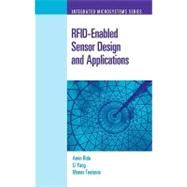
Rfid-enabled Sensor Design and Applications
by Rida, Amin; Yang, Li; Tentzeris, Manos M.-

This Item Qualifies for Free Shipping!*
*Excludes marketplace orders.
Rent Textbook
Rent Digital
New Textbook
We're Sorry
Sold Out
Used Textbook
We're Sorry
Sold Out
Summary
Author Biography
Table of Contents
| Preface | p. xi |
| Automatic Identification Systems | p. 13 |
| Barcode Systems | p. 15 |
| Magnetic Stripe Card | p. 16 |
| Smart Cards | p. 17 |
| RFID Systems | p. 18 |
| Definition | p. 18 |
| History of RFID | p. 19 |
| Beyond RFID: RFID-Enabled Sensors | p. 23 |
| References | p. 24 |
| Fundamentals and Operating Principles for RFID | p. 27 |
| RFID Tag Components | p. 27 |
| Tag Antenna | p. 28 |
| Integrated Circuits | p. 30 |
| Substrata | p. 30 |
| RFID Tag Types | p. 31 |
| Passive Tags | p. 31 |
| Active Tags | p. 33 |
| The 1-Bit Transponder and Chipless Tags | p. 34 |
| RFID Readers and Middleware Component | p. 34 |
| RFID Readers | p. 34 |
| RFID Middleware | p. 35 |
| Communication Fundamentals in RFID Systems | p. 36 |
| Coupling Mechanisms | p. 36 |
| Data Encoding | p. 37 |
| Multipath Effect | p. 39 |
| Tag, Reader, and Sensor Communication | p. 41 |
| Passive Systems | p. 43 |
| Active Systems, UWB, Zigbee, and Wi-Fi Tags | p. 44 |
| Licenses and Standards for Global Operation | p. 45 |
| References | p. 47 |
| Fundamentals and Operating Principles of Sensors | p. 49 |
| Types of Sensors | p. 49 |
| Use of Sensors | p. 49 |
| Types of Sensors | p. 51 |
| Basic Considerations of Sensor Design | p. 53 |
| What to Measure | p. 53 |
| Requirements for Accuracy | p. 53 |
| Requirements for Resolution | p. 54 |
| Environment of the Sensor | p. 54 |
| Calibration | p. 54 |
| Wireless Sensors and Wireless Sensor Networks | p. 55 |
| References | p. 58 |
| Design of RFID-Enabled Sensors | p. 59 |
| RFID Antenna Design Challenges | p. 59 |
| Antenna Basics and the Dipole | p. 60 |
| Passive RFID Antennas Using Serial Stubs | p. 64 |
| Bowtie T-Match RFID Antenna | p. 75 |
| Passive RFID Antenna Using Inductively Coupled Feed Structure | p. 81 |
| Active RFID Monopole Antenna Design | p. 85 |
| Integrated Circuit Design | p. 95 |
| Voltage Multiplier for RFID Integrated Circuits | p. 95 |
| Microcontroller for Active RFID-Enabled Sensor | p. 98 |
| Characterization and Development of Printed Circuit Boards or Substrates | p. 105 |
| Integration and Packaging: Integration of Sensors and RFID: Design Examples | p. 119 |
| Single-Layer, Dipole-Based Sensor Wireless Module | p. 120 |
| Double-Layer Monopole-Based Sensor Wireless Module | p. 122 |
| Fabrication/Assembly of the Dipole- and Monopole-Based Wireless Sensor Modules | p. 125 |
| Power Consumption and Link Budget | p. 137 |
| References | p. 141 |
| State-of-the-Art Technology for RFID/Sensors | p. 145 |
| Inkjet-Printed Technology | p. 145 |
| Flexible Low-Cost Substrate | p. 149 |
| Paper as the Ultimate Solution for a Low-Cost Environmentally Friendly RF Substrate | p. 150 |
| Liquid Crystal Polymer: Properties and Benefits for RF Applications | p. 152 |
| Dielectric Characterization of the Paper Substrate | p. 153 |
| Cavity Resonator Method | p. 157 |
| Maintenance-Free RFID-Enabled Sensors | p. 160 |
| Power Scavenging: Wearable Battery-Free Active RFID Tag with Energy Scavenger | p. 169 |
| Energy-Harvesting Unit | p. 171 |
| Shoe-Mounted Antenna Design | p. 173 |
| Circuit Implementation | p. 178 |
| References | p. 184 |
| Worldwide Applications | p. 189 |
| Logistics/Supply Chain | p. 190 |
| Automotive | p. 194 |
| Healthcare Monitoring | p. 194 |
| Space and Navigation Systems | p. 199 |
| References | p. 200 |
| About the Authors | p. 201 |
| Index | p. 203 |
| Table of Contents provided by Ingram. All Rights Reserved. |
An electronic version of this book is available through VitalSource.
This book is viewable on PC, Mac, iPhone, iPad, iPod Touch, and most smartphones.
By purchasing, you will be able to view this book online, as well as download it, for the chosen number of days.
Digital License
You are licensing a digital product for a set duration. Durations are set forth in the product description, with "Lifetime" typically meaning five (5) years of online access and permanent download to a supported device. All licenses are non-transferable.
More details can be found here.
A downloadable version of this book is available through the eCampus Reader or compatible Adobe readers.
Applications are available on iOS, Android, PC, Mac, and Windows Mobile platforms.
Please view the compatibility matrix prior to purchase.
